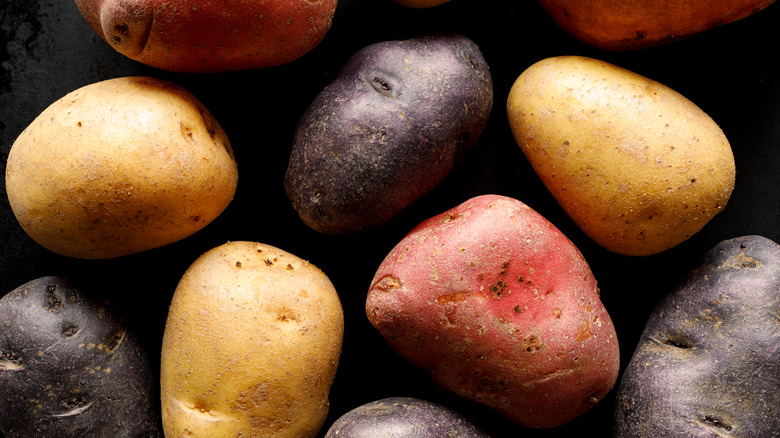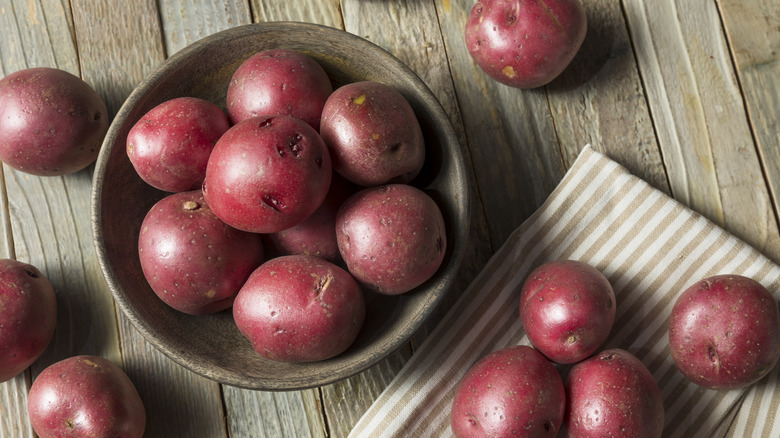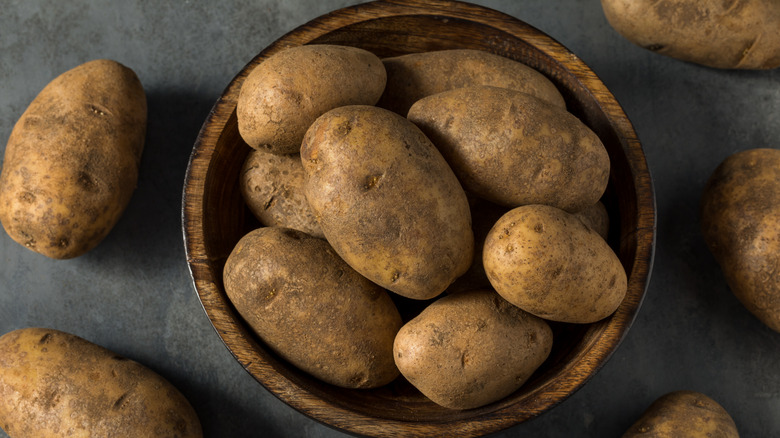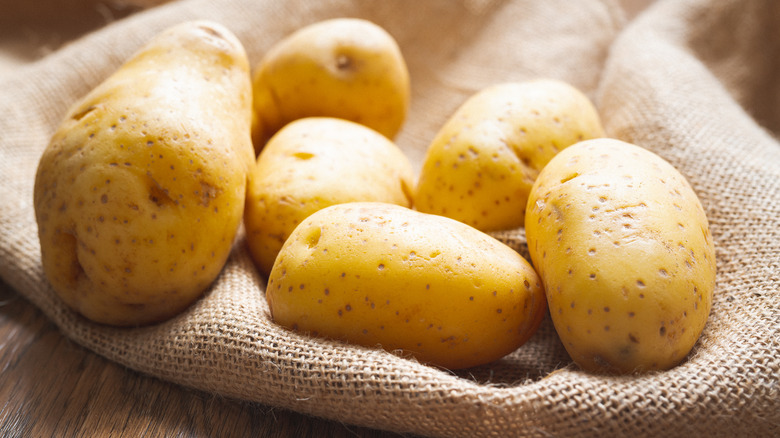Waxy Vs Starchy Potatoes: Which Types To Use And When
Potatoes are a staple food in many American homes, so common that they seem mundane. The world of potatoes, however, is far more diverse than you'd likely imagine. There are thousands of potato varieties, with about 100 unique cultivars grown commercially in the U.S. alone. Each type of potato has unique traits in terms of taste, texture, and usage. It would be an impossible feat to detail every individual potato cultivar, but for culinary purposes, they can broadly be grouped into the categories of waxy and starchy potatoes.
Potatoes exist a long a texture spectrum ranging from waxy to starchy. Waxy potatoes that are generally smaller and have firm flesh which doesn't lose its shape when cooked. Their starchy counterparts bigger potatoes with soft, mashable flesh. There are also spud varieties that fall in the middle of the spectrum, referred to as all-purpose potatoes. Each group has its own strengths and limitations.
Use waxy potatoes for roasting and boiling
Waxy potatoes are characterized by low starch and high moisture levels. This makes the flesh slightly firm to the tooth, although once you sink your teeth in, you'll find that it has a creamy quality thanks to the moisture. These tubers also have thinner waxy skin, hence their name. When you slice a waxy potato open, the flesh should be a little bit shiny, reflecting the high water content.
The types of potatoes do not break down when you cook them, which is why they are best for dishes in which you want them to retain their shape, like roasted potatoes or herbed potato salad. Conversely, waxy varieties make lousy mashed potatoes because the firm flesh will not easily give under the pressure of a potato masher, leaving you with big chunks throughout the dish. Another key trait is higher sugar content, which will lend a slightly sweet flavor to whatever dish you make.
Waxy potatoes tend to be on the small to medium side, such as fingerling potatoes or yellow. Another sign to look for is red skin, as most of these varieties fall under the waxy category, including the popular Red Bliss potato. There are also new potatoes, which are actually just potatoes harvested at a young age, and may come from a variety of different cultivars.
Use starchy potatoes for baking and mash
Starchy potatoes, sometimes called floury potatoes, are the opposite of waxy potatoes in that they have a high level of starch and low level of moisture. When you cook these potatoes, the starches inside them expand, creating a fluffy, crumbly interior. Their skins are typically thicker than waxy potatoes but split apart during cooking due to the expanding starch. Although starchy potatoes are mostly larger than waxy potatoes, they are far more fragile, and they won't hold their shape when you boil them.
Starchy potatoes are soft, easily giving way under pressure. This makes them the ideal choice for heavenly mashed potatoes, as you can whip them to a uniformly smooth consistency, and the starches ensure a light and fluffy texture. Another strength of starchy potatoes is the fact that, because they are naturally low on moisture, their flesh readily absorbs butter, making them a fantastic base for restaurant-style baked potatoes. One cooking method in which starchy potatoes do maintain their shape is frying, and they are popular options for making French fries and chips.
Starchy potatoes tend to be considerably larger than their waxy counterparts. The most common example is the russet potato, which accounts for the majority of potatoes grown in the U.S. Idaho potatoes are another popular variety of white starchy potato. The last varieties of starchy potato that you'll commonly see in stores are sweet potatoes. Most sweet potatoes are starchy, including jewel yams, which are not actually yams, but rather mislabeled potatoes.
All-purpose potatoes strike a good balance
The broadest category of potatoes falls in between waxy and starchy. These are known as all-purpose potatoes, so named because you can freely swap them with either waxy or starchy potatoes. They contain moderate amounts of both water and starch, balancing the two traits. All-purpose potatoes maintain their shape when roasted, boiled, or fried, but they are also soft enough that they will give under a little pressure, making creamy mashed potatoes. They work well for practically every potato-based dish, particularly in soups and gratins, where they will hold their shape but still absorb flavorful broths, butter, and cream.
Perhaps the most popular variety of all-purpose potato is the Yukon Gold, which was introduced in the 1960s by potato breeders in Canada. It has gone on to become one of the most common types in the country, particularly among restaurant chefs. Yukon Gold potatoes are excellent for boiling, mashing, frying, roasting, and just about any other preparation you can think of (although they are on the smaller side, making them a poor option for baked potatoes). Other popular varieties of all-purpose potatoes include Kennebec, considered by some to be the best potato for fries and chips, as well as blue potatoes.



